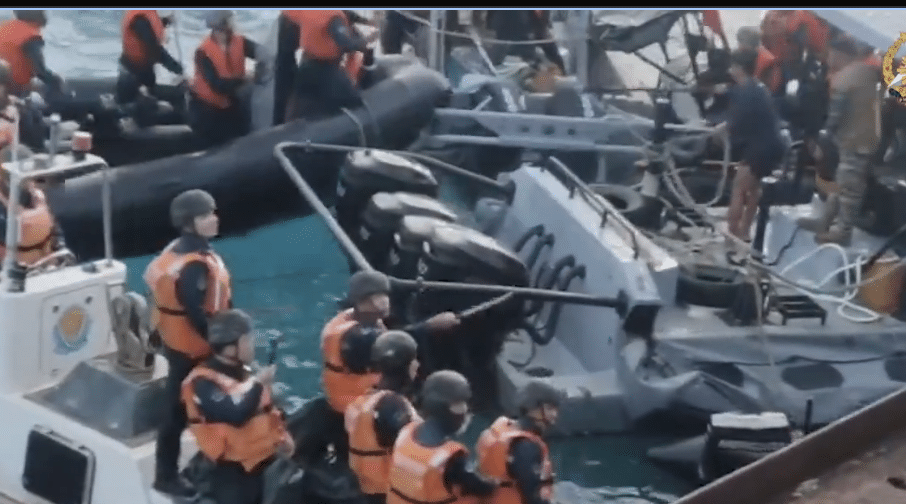The Philippines has leveled allegations of a “brutal assault” against China’s Coast Guard. This recent incident has sparked a considerable escalation in an ongoing dispute and may potentially involve the United States in another global conflict.
On Thursday, the Philippine military revealed footage showing Chinese Coast Guard officers wielding an axe and various other bladed instruments, slashing at Filipino soldiers and their rubber boat. The Manila government has tagged this as “a brazen act of aggression.”
The Philippines have released video footage of yesterday’s violent attack by the Chinese Coast Guard against the Philippine Navy while they were resupplying the BRP Sierra Madre on Filipino waters.
The Chinese used knives and axes during the attack
🇵🇭🇨🇳 pic.twitter.com/cBWcfuiXHf
— Visegrád 24 (@visegrad24) June 20, 2024
This incident occurred near the Second Thomas Shoal in the contested Spratly Islands. Both China and the Philippines are placing blame on each other for the occurrence, which transpired during a Philippine mission to resupply soldiers stationed on a beached World War II-era warship. This ship represents Manila’s territorial claims over the atoll.
The event is the latest in an escalating series of confrontations in the resource-rich and strategically critical South China Sea. However, the footage of this event signifies a turning point in tensions, as China appears to be adopting new, more openly aggressive tactics. Analysts suggest these tactics seem designed to test the responses of the Philippines and the U.S., its primary defense ally.
The Armed Forces of the Philippines has released footage of the June 17 confrontation between their troops and the Chinese Coast Guard at the Scarborough Shoal in the South China Sea.
🧵
(1) Amid blaring sirens, the CCG forcibly tows away a Philippine military rubber boat… pic.twitter.com/aghIc47IkP
— Barnaby Lo 吳宗鴻 (@barnabychuck) June 19, 2024
China maintains “indisputable sovereignty” over almost the entire South China Sea, including the islands and sandbars within it, even those hundreds of miles from mainland China. But, several governments, including Manila, have competing territorial claims.
Collin Koh, a research fellow at the S. Rajaratnam School of International Studies in Singapore, highlighted the unprecedented act of China’s maritime law enforcement boarding a Philippine naval vessel.
At a news conference on Wednesday, senior Philippine military officials reported that China’s Coast Guard officers “illegally boarded” the Philippine rubber boats. They allegedly “looted” seven rifles from gun cases, “destroyed” outboard motor, communication and navigation equipment, and confiscated the personal cellphones of Filipino personnel.
China’s Foreign Ministry has reiterated Beijing’s claims over the Second Thomas Shoal without directly addressing these allegations.
The ongoing conflict in the South China Sea carries significant implications for the U.S., which has a longstanding mutual defense treaty with the Philippines.
This recent clash is the first since a new law was enacted in China, permitting its coast guard to seize foreign ships and detain crews suspected of trespassing for up to 60 days without trial.
Matthew Miller, a spokesman for the US State Department, has expressed America’s support for the Philippines, condemning China’s “escalatory and irresponsible actions”.
Analysts suggest that if China continues its aggressive actions, it could trigger mutual defense commitments between the U.S and the Philippines. However, it would require the Philippines to initiate a move to activate it before the U.S would intervene militarily.
Despite an international tribunal ruling in favor of the Philippines’ claims in a landmark maritime dispute in 2016, Beijing has disregarded the verdict. Instead, China has increasingly pushed its maritime territorial claims.
The recent decision by China’s Coast Guard to use bladed weapons in the South China Sea clash has been compared to clashes between China and India on their disputed Himalayan border.
According to Koh, China is testing both Manila and Washington to determine their limits. Beijing is trying to gauge how far the U.S is willing to pledge its security commitment to the Philippines. These calculated risks, though potentially escalating the situation, were deemed worth taking by Beijing.


